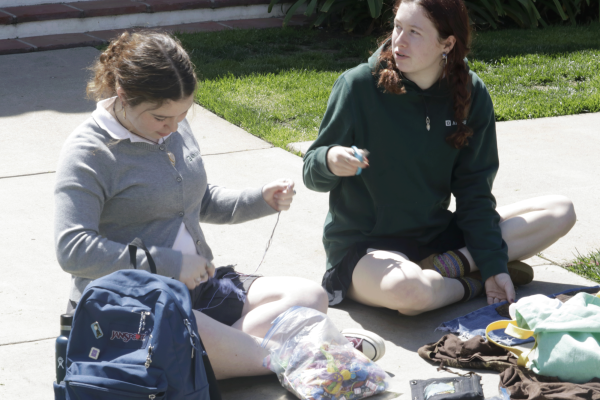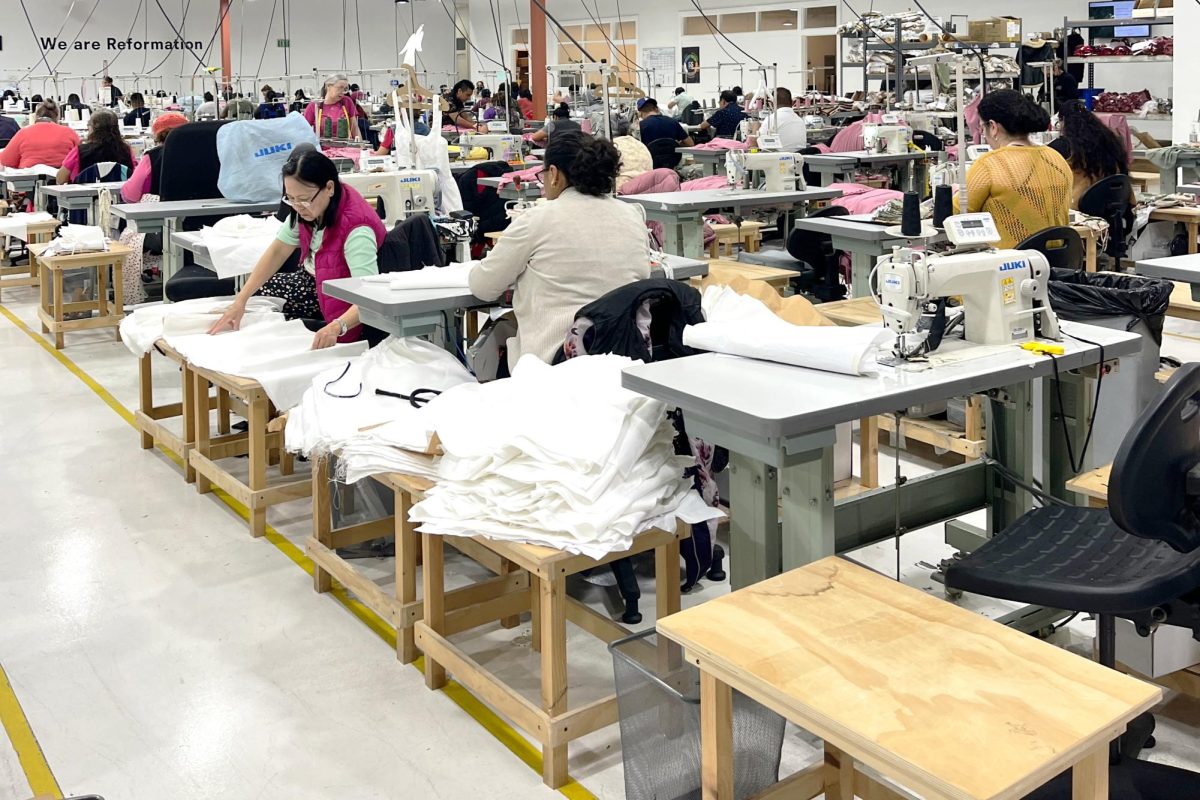A pair of boots and a black mini skirt that are absolutely to die for. A knit white sweater, fun red top and the cutest pair of jeans you have ever seen. This kind of shopping spree may seem to only hurt your wallet, but it does more than just that — it also negatively impacts the planet. The global fashion industry is responsible for 10% of greenhouse emissions annually, and this number is increasing. In response to this issue, individuals and companies have taken efforts to consume and produce clothes more sustainably.
Challenges in shopping sustainably
Sustainable fashion can be more challenging to manage than shopping ethically in other industries, Ken Pucker, a professor of Sustainable Business Dynamics at Tufts University, explained. For instance, when deciding between a polyester and a cotton shirt, they both have potential downsides; cotton is more water consumptive than polyester, but polyester produces worse carbon emissions.
“There’s a whole bunch of complexities,” Pucker said. “It’s not only difficult to understand what to look for in a clothing item, consumers also don’t know what claims to believe when companies are telling them something is sustainable. How do they know?”
Historically, there has been a lack of regulation on what brands can put forth as a sustainability statement. In the U.S, companies have put out inaccurate information and greenwash consumers into believing the company is sustainable. Greenwashing is when a company puts out false or misleading information to make a product appear more sustainable.
However, a bill was passed in October 2023 stating certain companies operating in California will have to disclose environmental information to the public by 2026. Companies making over 500 million dollars in annual revenue will be required share how climate change impacts their business. Companies making over one billion dollars annually will have to explicitly report greenhouse gas emissions.
Aisling MacIsaac is a sales supervisor at Reformation in the Pacific Palisades. The brand Reformation is dedicated to sustainability and they aim to be transparent in their environmental statements.
“I feel like there are a lot of brands that do quite a bit of greenwashing. Nowadays, they’ll use buzzwords,” MacIsaac said. “Reformation is actually doing the work behind what they say they’re doing. They’re influencing other brands to have to step up as well.”
Not only is it difficult for consumers to trust companies, but the information they release can be hard for non-experts on sustainability to understand.
“I think that if [the sustainability statement is] numerical, it can be more difficult to understand,” Sophomore Charlotte Stein said. “But if they say it using words and put it in layman’s terms, it’s easier.”
Reading through a company’s environmental statement and trying to understand it can be time consuming. Additionally, it can be inconvenient for consumers, when shopping in person, to look at the sustainability section of each brand’s website. Stein said she considers sustainability more when shopping online because she can look at the websites easily.
“I think in person it’s a lot harder because you’re in one location,” Stein said. “It’s hard to do research before.”
Pucker recommended building trust with brands that are sustainable rather than checking sustainability statements. There are many brands that have taken action to become more sustainable and have set clear goals. Pucker shared some brands that he has built trust with, including Unless Collective, Another Tomorrow, Early Majority and Reformation.
“It’s better for you to make a judgment based on a brand like Patagonia [or] Reformation and how they’re trying than it is to look at a sustainability report,” Pucker said. “You want to understand most of it, and a lot of the data is not accurate, and so it’s hard.”
Unsustainable shopping practices
Cost is another component making it difficult for consumers to shop ethically. In general, sustainable products are marked-up to due the additional financial cost it takes for companies to source and produce products sustainably.
An easy way to consciously consume and spend less money is to simply buy less. According to McKinsey and Company, between 2000 to 2014, the amount of clothing purchased annually increased by 60%, and this number is still on the rise. Overconsumption can partially be attributed to rapidly changing fashion trends.
“If fashion didn’t change what was ‘in’, then you wouldn’t have to buy new stuff,” Pucker said. “It’s called planned obsolescence.”
According to Fashion United, companies design poor quality garments that will lose popularity quickly, so subsequently, consumers are constantly buying more products.
Fast fashion brands utilize planned obsolescence by producing cheaply made clothing for each micro-trend. Since trends can die in such short periods of time, much of the clothing consumption they encourage goes to waste. According to True Cost, 80 billion new clothing items are consumed each year — a 400% increase from 20 years ago.
On of the largest fast fashion companies in the world is Shein. According to Time, the brand emits 6.3 million tons of carbon dioxide each year.
“This year [Shein] will make 3 billion items. Think about how long those get worn and where they end up,” Pucker said. “It’s a lot of oil.”
Stein said her generation’s social media usage impacts the importance they place on keeping up with trends. Micro-trends are brief and niche trends that will blow up on social media platforms like TikTok and Instagram but will then fade out quickly. Stein said she tries to buy pieces she predicts will stay in style for long periods of time.
“I try to pick more timeless pieces,” Stein said. “So, I’m not rebuying pieces that are going to quickly go out of fashion and that I don’t really love.”
Thrifting as alternative
Archer Council for Sustainability member Kate Hanney (‘25) said shopping sustainably and inexpensively can go hand in hand. Buying secondhand is a cheap alternative that does not have the same environmental implications buying new clothes has.
“If you go to the Goodwill bins, you can get five new pairs of jeans for 20 bucks,” Hanney said. “But, if you go to Urban Outfitters, that’s like $300 or more.”
Sophomore Josie White is the co-leader of EcoStitch along with Liv Karp (’26) and Sylvie Haacker (’26). In their club, they thrift and upcycle clothing. White said if she wants a piece of clothing, she’ll take an old piece and sew it into something new.

“There’s no need to create more of what we already have,” White said. “It’s a thought process of when I’m shopping. ‘Do I really need this? Don’t I have something like this already home that I have? Can I make it into something?’”
Hanney has been thrifting most of her clothes since she was 13.
“It does take a lot of effort to like find what you’re looking for,” Hanney said. “But once you find a couple stores that are consistently good, it’s pretty easy to find stuff.”
Thrifting has been increasing in popularity in recent years. According to the Ellen MacArthur Foundation, “the secondhand market is expected to grow 1.5 times the size of fast fashion by 2028.”
“I decided that’s the one thing that I can do to help,” Hanney said. “If everyone decided to do that, I think that would make a huge change.”
Pucker said it’s not just an individual’s job to ethically consume but that companies need to change their practices too. Pucker said, in the fashion industry, there are conversations happening surrounding sustainability, but it is mostly performative. In his experience, there is not much change in regard to company behavior since financial teams have more power and more say in the company than sustainability teams.
“Until sustainability gets a seat at the table as an equal partner,” Pucker said, “Then the pressures … that are financial will continue to have more influence.”
This story was originally published on The Oracle on May 21, 2024.




































